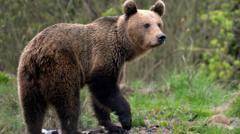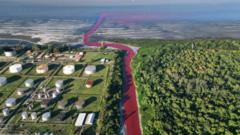A rising population of capybaras in Nordelta, Argentina, is leading to controversial sterilization efforts aimed at controlling their numbers, highlighting the complex relationship between affluent residents and local wildlife.**
Capybara Controversy: Managing Overpopulation in Argentina's Nordelta**

Capybara Controversy: Managing Overpopulation in Argentina's Nordelta**
Addressing the capybara overpopulation in Argentina's upscale Nordelta community sparks debate over wildlife coexistence and management strategies.**
In the exclusive community of Nordelta, just north of Buenos Aires, a peculiar issue has emerged involving the world’s largest rodent—the capybara. Luciano Sampietro, a local veterinarian, wields a blowgun equipped with sedatives to manage this growing issue. Just recently, he successfully sedated a large male while a female, already pregnant, was also treated but ultimately left to avoid further complications.
The capybara phenomenon has gained popularity beyond Nordelta, often depicted in playful images and videos on social media, attracting a dedicated fanbase globally. Known for their friendly demeanor and the ability to coexist with various species, these creatures have captured the hearts of many. However, in Nordelta, their increasing numbers have begun to raise concerns among residents, prompting the community to implement sterilization programs to control the population.
As urban development has expanded into natural habitats, the balance between wildlife and residential living is now being tested. The once-lush areas inhabited by capybaras are being reshaped into residential lots and golf courses. With residents expressing mixed feelings about these gentle giants occupying their neighborhood spaces, the local wildlife management policies have become a topic of heated debate.
As the residents and wildlife coexistence saga unfolds, Nordelta serves as a case study, indicating that informed and sensitive management is essential in harmonizing human needs with wildlife preservation. The ongoing discussions highlight a critical examination of how affluent communities engage with local biodiversity and what measures should be taken in future urban planning.
The capybara phenomenon has gained popularity beyond Nordelta, often depicted in playful images and videos on social media, attracting a dedicated fanbase globally. Known for their friendly demeanor and the ability to coexist with various species, these creatures have captured the hearts of many. However, in Nordelta, their increasing numbers have begun to raise concerns among residents, prompting the community to implement sterilization programs to control the population.
As urban development has expanded into natural habitats, the balance between wildlife and residential living is now being tested. The once-lush areas inhabited by capybaras are being reshaped into residential lots and golf courses. With residents expressing mixed feelings about these gentle giants occupying their neighborhood spaces, the local wildlife management policies have become a topic of heated debate.
As the residents and wildlife coexistence saga unfolds, Nordelta serves as a case study, indicating that informed and sensitive management is essential in harmonizing human needs with wildlife preservation. The ongoing discussions highlight a critical examination of how affluent communities engage with local biodiversity and what measures should be taken in future urban planning.


















